As probably one of their most ambitious projects to date, award-winning British sample library developer Spitfire Audio just released an orchestral string library that carries the name of one of the best and most successful film composers of our time: Hans Zimmer Strings.
Having scored iconic soundtracks for Oscar-winning films like Gladiator, Pirates Of The Caribbean, The Dark Knight, Interstellar or Dunkirk, Zimmer is well-known for integrating electronic and sampled sounds with traditional orchestra in order to achieve his trademark bombastic, larger-than-life sound. As the godfather of orchestral sampling himself states: “The true magic of sampling is when you are creating something that’s impossible in reality.”
For the freshly introduced Hans Zimmer Strings, this meant gathering not less than 344 of Britain’s top string players to capture their large-group performances in London’s iconic AIR Lyndhurst Hall.
We got our hands on a copy of Spitfire Audio‘s controversially discussed Hans Zimmer Strings and put it to the test. In this review, we’re going to find out together if Hans Zimmer Strings can deliver what its large-scale marketing campaign promised and how much of HZ’s magic is really hiding in this unique new library.
OVERVIEW
For Hans Zimmer Strings, Spitfire Audio adopted the film composer’s concept of capturing unusually large groups of instruments to achieve massive and hyper-realistic sounds. Being their go-to recording location for orchestral sampling, the developers again chose AIR Lyndhurst Hall as their place to record 344 of London’s best string players. Spitfire Audio made use of AIR Lyndhurst Hall’s unique architecture (including the raised galleries), to capture both full and more broken down sections of 60 violins, 20 violas, 60 cellos and 24 basses, using up to 26! different microphone positions for each section. The players of the four instrument groups break down into the following, individually playable ensembles:
-
Violins (60 full, 20 right, 20 centre, 20 left, and 20 galleries)
-
Violas (20 centre and 20 wide)
-
Cellos (60 full, 20 right, 20 centre, 20 left, and 20 galleries)
-
Basses (24 centre)
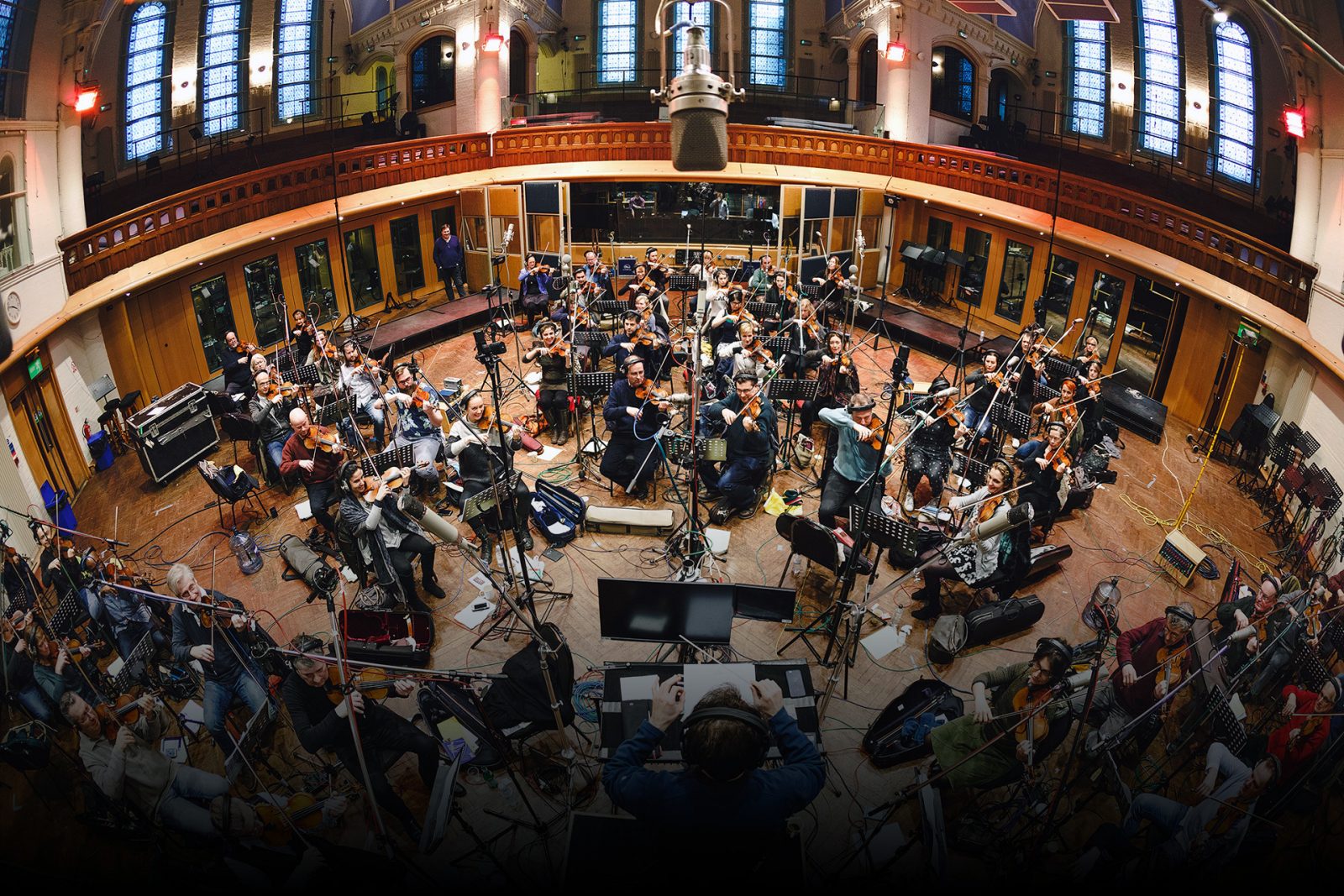
For each of those groups, the developers captured a variety of different articulations which add up to 147 available techniques in total.
With over 205,000 samples taken, the 182 GB large library can both be downloaded via Spitfire Audio’s own download manager or be ordered on its own external hard drive.
For the first time ever, Spitfire Audio refrained from using Native Instrument‘s KONTAKT engine to program their orchestral library but chose to come up with their very own dedicated sampler for Hans Zimmer Strings. Let’s have a look at how the new plugin works!
THE HANS ZIMMER STRINGS PLUGIN
In trying to provide a unique, clutter-free and intuitive sampler engine, Spitfire Audio decided to turn away from KONTAKT and designed their very own plugin for Hans Zimmer Strings. The company teamed up with design and user experience agency UsTwo to create a clear and inspiring GUI.
The HZ Strings plugin comes in AAX, AU, VST2, and VST3 and can be used with most modern DAWs.
When launching HZ Strings for the first time in my project, it made a pretty good first impression. The plugin features a sleek and tidy interface which is, to be honest, not that far away from KONTAKT in terms of the controls and functions both engines share. It’s roughly divided into two main sections, one of which can be collapsed and hidden if not needed at the moment. The upper section features just three controls – two sliders and a big knob which are assigned to different modulation functions. While the two sliders control expression and dynamics, the big knob can be freely assigned to one of a couple of available controls: reverb amount, vibrato, tightness and release. For short articulations, the modwheel position compresses the dynamic range of the instruments (high position: loud dynamics even if the keys are played softly, low position: velocity-dependant)
Also found in the upper half of the GUI are global controls like volume, panning, tuning as well as some information on the memory size, CPU usage and voices.
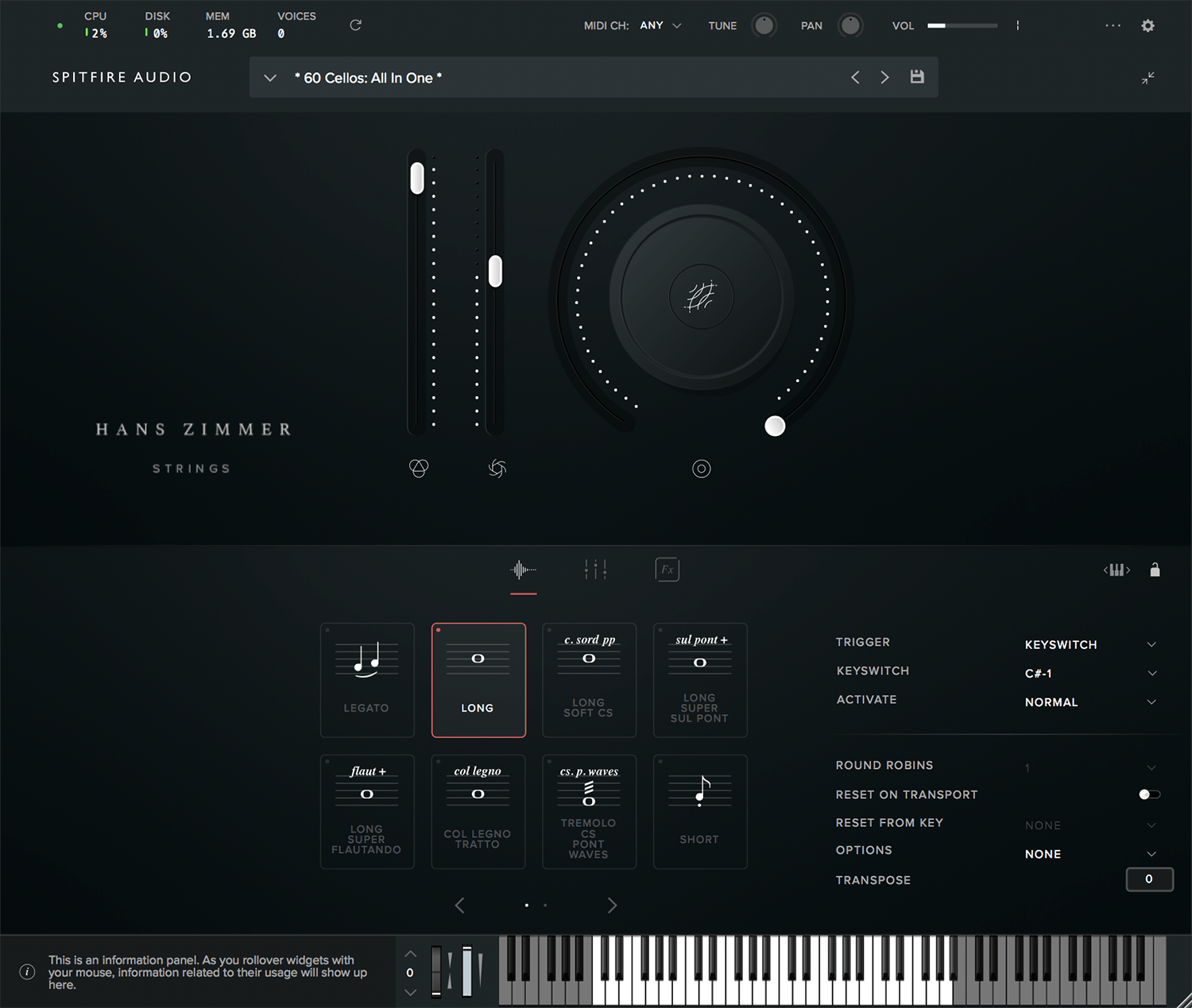
The lower half of the interface is broken up into three different pages of controls. The first page which comes up by default shows the articulations loaded with the respective patch (in case of a multi-articulation patch) and also features quite a few adjustment options on the right. These include keyswitch assignment, round robins or transposition on a per-articulation basis. The second page provides you with the library’s comprehensive collection of microphone positions which obviously differs depending on the instrument group you loaded. By dragging a respective microphone’s slider up, you can create your own blend of sounds. Dragging the slider down to its minimum position automatically unloads a given mic from the memory. Another useful feature is the option to either make microphone mix changes on a global level or assign every articulation loaded with its own blend.
If you don’t want to bother with all the different microphone positions, you can also set the Advanced Mode to Off on the left hand side and get to the Easy Mode. Here you are provided with a more simple “Close / Far” slider that automatically creates a blend of the Close, Tree and Far mics depending on its position.
The third and last page of the lower part of the interface gives you an overview of the assignable “FX”, as Spitfire calles them. These are the same that can be assigned to the interface’s big knob in the upper section.
The interface of Hans Zimmer Strings also comes with a neat patch browser that includes filtering by instrument and articulation type. Spitfire Audio assembled a lot of useful pre-defined multi-articulation patches which include either all or a selection of similar playing techniques in one patch.
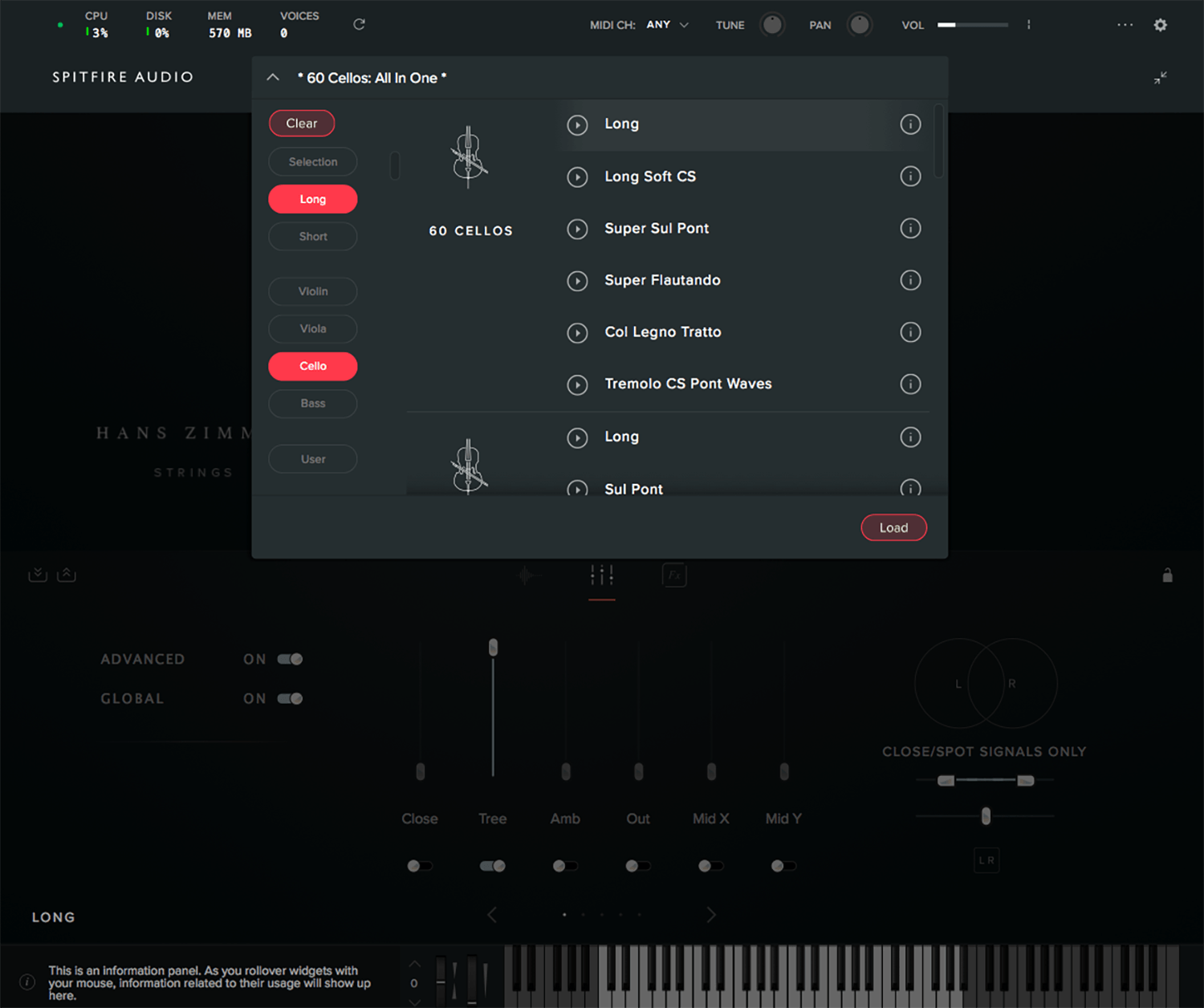
Lastly, most of the parameters of the HZ Strings plugin turn up in your DAW’s automation section, which allows for automated changes over the course of a track.
HANS ZIMMER STRINGS IN USE
Let’s take a look at the performance and usability of the library. To start with, if you’re planning on getting Hans Zimmer Strings, please make sure to put the sample library on a pretty fast and not too cluttered hard drive, preferably an SSD. The HZ Strings plugin can get pretty demanding in terms of CPU usage especially if you’re using multiple instances with lots of different mic positions loaded. The loading times of patches remain within a normal range although some of the multi-articulation “All in one” patches can take a bit longer.
As mentioned in the previous chapter, HZ Strings’ GUI is laid out pretty neatly and doesn’t require much learning – especially if you’re used to working with sample libraries in KONTAKT. While the majority of controls are more or less self-explanatory, for most functions there is a help text that pops up in the bottom left corner as soon as you click on a knob or slider. Although working in the HZ Strings plugin goes very smoothly in general, there are a couple of technical bugs apparent in the current release (version 1.0.3) that can make things a bit cumbersome at times. One of them is the resetting of the global volume’s position whenever you load a new patch. This may not sound like much of a problem but since quite a good deal of articulations reside on the lower side of dynamics it can get pretty annoying to keep dialing the volume back up for every new patch you load.
Also, there are still some notes cutting off in a couple of patches (Spitfire already announced an update fixing this). Not really a bug but more like a poor design choice is that in the microphone position tab, some mics belonging together don’t reside on the same page. The three close mics for Left Center and Right for example are spread across two pages, which makes setting up a proper close mic balance a bit annoying. Maybe it would be a good idea to push some of the more esoteric ones, like the Bottle or Quad mics to the back and keep connected mics together at the front.
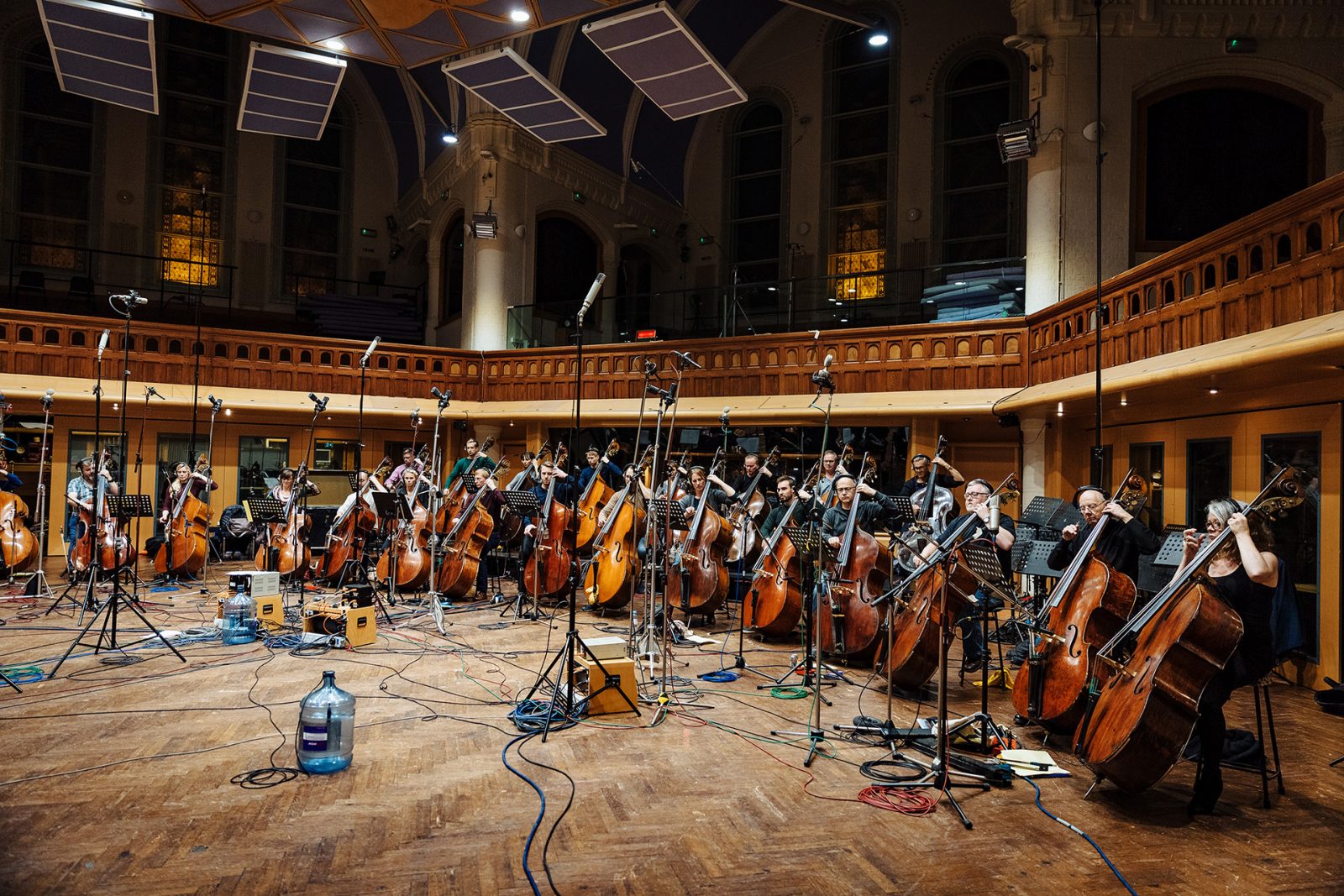
Also not really a bug but still somewhat inconvenient is that the keyswitches on multi-articulation patches are positioned in the very low C-1 to B-1 region which involves a lot of switching for and backwards between octaves, especially if you’re using a keyboard with less than 88 keys. You can however assign every articulation to your very own keyswitch of choice on the right side of the GUI’s articulation tab.
THE SOUND OF HANS ZIMMER STRINGS
Let’s come to the essential question probably everyone is asking by now: “But…but how does the damn thing sound?“. If you followed some of the discussion going on in music production forums, on Youtube or social media, I’m sure you witnessed how this library seems to divide the media composer’s community ever since its release just a week ago. Probably the biggest controversy going on right now is the expectation everybody built up for the product, I guess. While for some, those expectations were fulfilled, others now express their anger, feeling ripped off or misled by this big name the library carries.
To be honest, when I first heard of Hans Zimmer Strings and 344 players, the thing that came to my mind were attributes like bombastic, epic, big. While the product’s sound definitely can sound very big, it’s surely not the essential core of it. Those idiomatic, massive short spiccato/staccato sounds everybody is associating with Hans Zimmer and his scores for Pirates Of The Caribbean or Inception actually only make up a small part of the whole thing. Pursuing their trademark sound aesthetics, Spitfire Audio rather seem to have focused on the quieter and more exotic playing techniques (similar to Albion V Tundra) and I will go on about why this makes sense in a second.
First, I’d like to express my feeling that some of the loudest voices against HZ Strings somehow seem to forget that while “massive” definitely is one of his trademarks, Hans Zimmer surely isn’t just all about loudness. Many of his scores feature a large potion of quieter, for a lack of a better word, brooding passages that set the mood and urgency of a scene perfectly. This was demonstrated very well in cues for award-winning films like Interstellar and just recently, Dunkirk.
“The Tide”, one of the tracks in Dunkirk, for example, manages to set a really tense and unnerving feeling just by layering what seems to be con sordino (muted) strings and string harmonics.
Click on the button to load the content from open.spotify.com.
Another thing that tends to be overlooked by some people in the composer’s community is the fact that not everybody composes epic trailer music. While I am, too, at home in this very musical genre, I know of many people who compose music for TV drama series or film, and I’m sure they appreciate an orchestral sound that has a unique texture to it rather than buying the 100th staccato patch.
Alright, with this out of my system, let’s get back to the actual sound of HZ Strings. What Spitfire Audio tried to showcase in my opinion is to convey that the power of a sound often lies in its quieter dynamics. This is a method, Mr. Zimmer captures most of his custom sounds with. In fact, this was already mentioned by Spitfire Audio’s Paul Thompson when taking about another sample library of the Hans Zimmer series – HZ Percussion. Find the related excerpt of the walkthrough video below (beginning of the marker to 6’30”):
So translated to strings, having a lot of players perform quiet articulations like sul tasto (playing close to the instrument’s neck) or flautando (soft, flute-like) together, the number of players not only reinforces a delicate sound, it also increases the volume of performance artifacts like bow noises, rosin noise, and overall airiness – in a good way. This yields a remarkably hyper-realistic sound which Spitfire Audio definitely managed to nail with HZ Strings.
The short articulations are powerful and snappy and I really love the scrubbing, slightly scratching quality these patches have in their higher dynamics. This raw texture gives the strings quite a modern, trailer music-type of edge. Especially the 24 basses sound beautifully gritty in their short articulations, even more so if you add in some of the close mic positions. One thing to keep in mind is, that when as many players come together like in HZ Strings, the timings of short articulations get a bit smeared by physical nature, even if they are performed by expert instrumentalists. Due to this, you may find it a bit hard to program really pronounced fast ostinati as really blazing fast lines get somewhat washed out. However, there’s a Tightness control available to cut in the start of the samples and add some more definition to the strokes. It would have been great to get a second, even faster set of articulations like spiccati or staccatissimi to emulate those typical HZ-style action string sequences.
The thick 60 and 20-string legato articulations sound really nice across all the sections and can go from round and soft to soaring in the higher dynamics. The actual legato sounds between the notes are rather subtle, so there’s not much portamento going on even if you play larger intervals. This is obviously a question of taste, but I personally like to hear a bit more of the slur and would have loved being able to choose the amount of the portamento myself. A real downer is that there are no round robins on the legato articulations so the start of the samples always sounds the same. This becomes very apparent when you try to play faster, repetitive legato lines. This flaw could have been avoided with just one or two more alternative sample starts.
One issue that is being discussed broadly is the internal balance and volume of sounds. While the legatos, sustained patches and shorts sound in a normal volume, most of the more unusual, long articulations like the “Super Sul Tastos” or “Tremolo Harmonic Waves” are much too quiet in comparison. Although you can make up for the missing volume using the global level control, this is only a temporary option since the respective control resets to default as soon as you change patches (see the “In Use” chapter above). Although I understand that Spitfire Audio probably is trying to keep a correct internal volume balance between different playing techniques, some patches just are too quiet to be practical. The “20 Celli Super Sul Pont” for example is barely audible, even if you add multiple microphones to the mix. This is a point where Spitfire Audio definitely need to work on a proper adjustment update.
Another sampling and programming decision that I have trouble getting my head around, is the distribution of patches across the different ensembles. While recording different articulations for the big 60-string ensembles and the smaller 20-string sections is something I’m able to relate to, having different sets of patches for the same set of players doesn’t make any sense at all. For instance: HZ Strings comes with three smaller violin sections apart from the big, 60-violins ensemble. Each one features 20 players but one was recorded on the left side of the hall, one in the center and the third one the right side of the hall. This allows you to expand a regular violin ensemble on a modular basis, which is a pretty neat idea, actually. However, the Left Hand Side Violins ensemble is missing articulations available on the right side, while the Right Hand Ensemble has patches that can’t be found in the Center Ensemble. The reason to put in different or less articulations in patches of the same type and size of ensembles is something that really needs clarification on behalf of Spitfire Audio.
CONCLUSION
It seems like consistency is really the weak spot of Hans Zimmer Strings (at least in the current release version). Those small to severe bugs and inconveniences you’re coming across don’t fit the impression and expectation potential customers were given with Spitfire’s massive promo campaign on the library. Also, it possibly would have been great if the developers decided to include some more articulations people associate with Hans Zimmer’s sound – which means expanding the short articulations range to be precise.
What makes it really hard to decide a clear verdict, is the remarkable sound of many of the patches included with HZ Strings. From the sustains and the tremolos to the more unconventional “super sul tasto” and “harmonic waves” patches, Hans Zimmer Strings features a beautiful, both lush and powerful sound that has quite a unique quality to it. Especially if you’re planning on using it for dramatic underscoring, this large-scale cinematic toolkit provides you with an amazing set of new brushes. However if you’re willing to pay big buck just for this is written on a completely different page I guess.
At the current time Hans Zimmer Strings is a great sounding but moderately executed sample library at best – with a potential to be really good, if Spitfire Audio comes up with a proper bug fixing update in the near future.
Hans Zimmer Strings is available through Spitfire Audio’s online store and comes with a limited promo price of $599 (regularly $799).
HANS ZIMMER STRINGS WALKTHROUGH
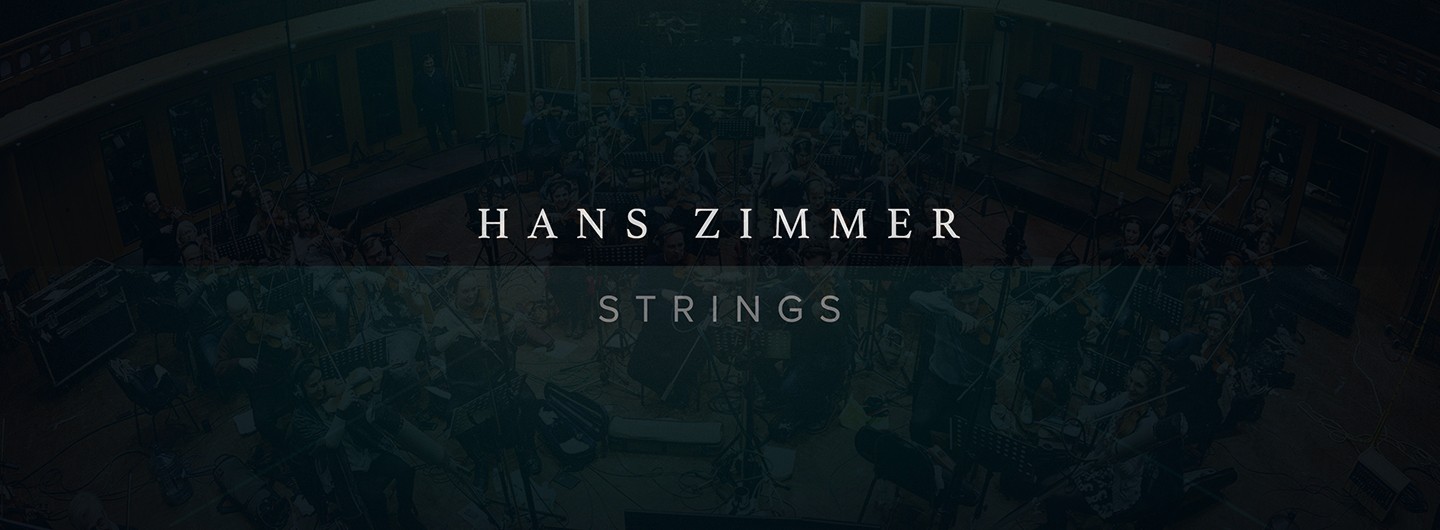

Pingback: mr. room | blogbossasworld